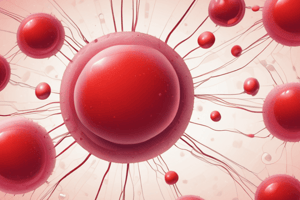Podcast
Questions and Answers
What hormone primarily regulates red blood cell (RBC) production in response to low oxygen levels?
What hormone primarily regulates red blood cell (RBC) production in response to low oxygen levels?
- Insulin
- Hemoglobin
- Thrombopoietin
- Erythropoietin (correct)
In which organ is the majority of erythropoietin produced?
In which organ is the majority of erythropoietin produced?
- Spleen
- Heart
- Kidneys (correct)
- Liver
What is one consequence of bone marrow destruction due to conditions such as x-ray therapy?
What is one consequence of bone marrow destruction due to conditions such as x-ray therapy?
- Increased oxygen transport
- Hyperplasia of remaining bone marrow (correct)
- Decreased white blood cell production
- Decrease in RBC production
What effect does hypoxia have on erythropoietin levels?
What effect does hypoxia have on erythropoietin levels?
What is the primary physiological response to decreased oxygen availability at high altitudes?
What is the primary physiological response to decreased oxygen availability at high altitudes?
What role does erythropoietin play in RBC production during anemias caused by bleeding?
What role does erythropoietin play in RBC production during anemias caused by bleeding?
What can happen if there is excessive production of immature red blood cells in response to high demand?
What can happen if there is excessive production of immature red blood cells in response to high demand?
Which bones are primarily responsible for RBC production after the age of 20?
Which bones are primarily responsible for RBC production after the age of 20?
What characterizes committed stem cells in blood cell differentiation?
What characterizes committed stem cells in blood cell differentiation?
What is a major function of the growth inducers in blood cell production?
What is a major function of the growth inducers in blood cell production?
Which interleukin is mentioned as a major inducer of stem cells?
Which interleukin is mentioned as a major inducer of stem cells?
What problem may arise if a stem cell is not committed to making a specific type of blood cell?
What problem may arise if a stem cell is not committed to making a specific type of blood cell?
Which bone types become less productive for RBC production with age?
Which bone types become less productive for RBC production with age?
What effect does aging have on bone marrow composition?
What effect does aging have on bone marrow composition?
How do growth inducers specifically enhance the production of different blood cell types?
How do growth inducers specifically enhance the production of different blood cell types?
What is the role of erythropoietin in RBC production?
What is the role of erythropoietin in RBC production?
What is the primary function of maintaining the ferrous form of iron in hemoglobin?
What is the primary function of maintaining the ferrous form of iron in hemoglobin?
At what stage of gestation does the primary site of red blood cell production shift to the bone marrow?
At what stage of gestation does the primary site of red blood cell production shift to the bone marrow?
Which of the following describes a characteristic of primitive red blood cells produced in the yolk sac?
Which of the following describes a characteristic of primitive red blood cells produced in the yolk sac?
What is the main cause of increased bilirubin levels in the body?
What is the main cause of increased bilirubin levels in the body?
How does aging affect red blood cell production in the bone marrow?
How does aging affect red blood cell production in the bone marrow?
What happens to the production sites of red blood cells after age 20?
What happens to the production sites of red blood cells after age 20?
Which of the following options best describes the fate of red blood cells?
Which of the following options best describes the fate of red blood cells?
What role do macrophages play in the lifespan of red blood cells?
What role do macrophages play in the lifespan of red blood cells?
Which of the following is true regarding membrane transport of ions in red blood cells?
Which of the following is true regarding membrane transport of ions in red blood cells?
What is the primary function of differentiation inducers in blood cell formation?
What is the primary function of differentiation inducers in blood cell formation?
Which factor influences the growth and differentiation of blood cells from hematopoietic stem cells?
Which factor influences the growth and differentiation of blood cells from hematopoietic stem cells?
What initiates the increased production of erythrocytes?
What initiates the increased production of erythrocytes?
What is the role of pluripotential hematopoietic stem cells?
What is the role of pluripotential hematopoietic stem cells?
What happens to the population of hematopoietic stem cells as a person ages?
What happens to the population of hematopoietic stem cells as a person ages?
What is a characteristic of mature erythrocytes?
What is a characteristic of mature erythrocytes?
What could happen if erythropoietin production is significantly reduced?
What could happen if erythropoietin production is significantly reduced?
What is the primary physiological purpose of maintaining red blood cell mass?
What is the primary physiological purpose of maintaining red blood cell mass?
What typically occurs in response to anemia and hemorrhage?
What typically occurs in response to anemia and hemorrhage?
What role does the liver play in erythropoietin production?
What role does the liver play in erythropoietin production?
What role does HIF-1 play in response to tissue hypoxia?
What role does HIF-1 play in response to tissue hypoxia?
What can result from prolonged cardiac failure?
What can result from prolonged cardiac failure?
How does anemia affect cardiac output?
How does anemia affect cardiac output?
What is the primary function of intrinsic factor?
What is the primary function of intrinsic factor?
During exercise, why can hypoxia lead to acute cardiac failure?
During exercise, why can hypoxia lead to acute cardiac failure?
What is a consequence of intrinsic factor binding with vitamin B12?
What is a consequence of intrinsic factor binding with vitamin B12?
What type of cells are produced in response to sufficient oxygen supply during anemia?
What type of cells are produced in response to sufficient oxygen supply during anemia?
What can exacerbate the condition of anemia during exercise?
What can exacerbate the condition of anemia during exercise?
What leads to unsatisfactory oxygen supply in the case of anemia?
What leads to unsatisfactory oxygen supply in the case of anemia?
Which condition can lead to significant blood-forming organ activity?
Which condition can lead to significant blood-forming organ activity?
Flashcards are hidden until you start studying
Study Notes
Erythropoietin
- Hormone that regulates red blood cell (RBC) production
- Produced mainly by the kidneys (90%) and liver (10%)
- Increases in response to low oxygen states (hypoxia)
- Stimulates bone marrow to produce more RBCs
Bone Marrow and RBC Production
- Primarily produces RBCs after birth
- At age 20, RBC production shifts from long bones to flat bones (ilium, ribs, sternum)
- Marrow becomes less productive as age increases
Stem Cells and RBC Differentiation
- Stem cells differentiate into specific blood cell types
- Committed stem cells are intermediate-stage cells committed to specific blood cell lines e.g., Colony-forming unit-erythrocyte (CFU-E) for erythrocytes
- Growth inducers, like interleukins-3, stimulate growth and reproduction of stem cells
RBC Life Cycle
- Starts in the yolk sac during early embryonic life
- Continues in the liver during the middle trimester of gestation
- Primarily produced in bone marrow during late gestation and post-birth
- RBCs live for 120 days
- Self-destruction occurs in the spleen, liver, and bone marrow
- Hemoglobin phagocytosis by macrophages leads to bilirubin production
Hemoglobin Synthesis
- Begins in the proerythroblast and continues into the reticulocyte stage
- Reticulocytes in the bloodstream continue hemoglobin synthesis until maturation
Effects of Deficiency
- Abnormal DNA synthesis leads to the production of larger-than-normal RBCs (macrocytes)
- Macrocytes have flimsy membranes, irregular shapes and a shortened lifespan
- Immature RBCs are produced in higher numbers due to bone marrow erythroblastic cell production
Iron Form in RBCs
- Iron in RBCs is in the ferrous form (soluble)
- Ferric form (insoluble) is not usable in RBCs
Anemia
- Highly anemic patients due to bleeding or other ailments have rapid bone marrow RBC production
- Increased production may lead to hyperplasia (overgrowth) of bone marrow and immature cell production
- This may lead to malignancies (cancers)
Polycythemia Vera
- High altitude leads to reduced oxygen in the air and an increase in RBC production due to decreased oxygen transport to tissues
Additional Points
- The prosthetic heme group of hemoglobin contains iron vital for oxygen transport.
- The red bone marrow is responsible for the production of red blood cells.
- The spleen is a major site for the destruction of old and damaged red blood cells.
- When iron is needed by the body for the synthesis of hemoglobin, it is released from storage in the liver, spleen, and bone marrow.
Blood Cell Formation
- Originates from pluripotent hematopoietic stem cells in the bone marrow.
- These stem cells give rise to all types of circulating blood cells.
- A portion of these cells remain in the bone marrow to sustain the stem cell pool, however, their numbers decrease with age.
Erythrocytes
- Mature erythrocytes are devoid of organelles, shrink down to become biconcave discs, and are devoid of nuclei.
- The maturation of RBCs happens in the blood, not the bone marrow.
- It's abnormal to see nucleated red blood cells, such as proerythroblasts or erythroblasts, outside the bone marrow.
RBC Differentiation
- Erythropoietin stimulates the production of proerythroblasts and speeds up their development through erythroblastic stages.
RBC Production Regulation
- Key function is to maintain RBC mass within tight limits.
- This ensures enough RBCs for effective oxygen delivery. It also avoids excessive RBC numbers that could impede circulation.
Hypoxia-Inducible Factors (HIF-1)
- These act as transcription factors for erythropoietin, a key differentiation inducer.
- They stimulate increased RBC production to compensate for low oxygen levels.
Vitamin B12 and Folic Acid in RBC Maturation
- Both are crucial for DNA synthesis, specifically the formation of thymidine triphosphate, a key DNA building block.
- A lack of vitamin B12 or folic acid leads to impaired DNA synthesis, resulting in aberrant and reduced DNA, which in turn causes nuclear maturation failure and cell division failure.
Pernicious Anemia
- Poor absorption of vitamin B12 from the gastrointestinal tract due to atrophic gastric mucosa, leading to inadequate gastric secretion.
- This condition results in anemia due to the failure to meet the body's vitamin B12 requirements.
Folic Acid Deficiency
- Deficiencies can occur due to inadequate intake or impaired absorption, such as in tropical sprue.
- Folic acid deficiency leads to impaired RBC maturation.
Hemoglobin Synthesis
- Begins in proerythroblasts and continues into the reticulocyte stage.
- Reticulocytes in the bloodstream continue hemoglobin synthesis for an additional day or so until maturation.
Studying That Suits You
Use AI to generate personalized quizzes and flashcards to suit your learning preferences.



